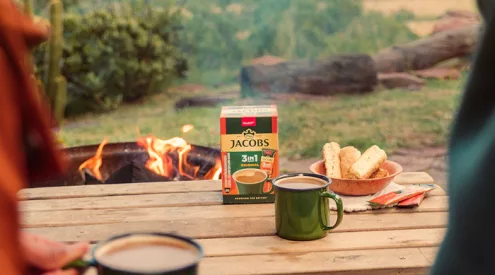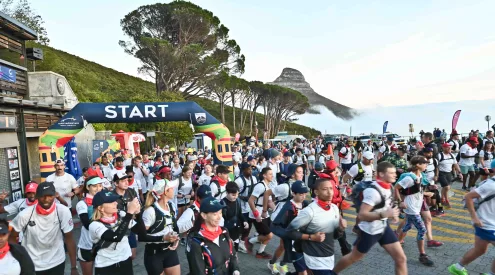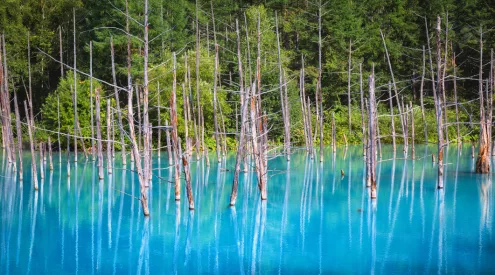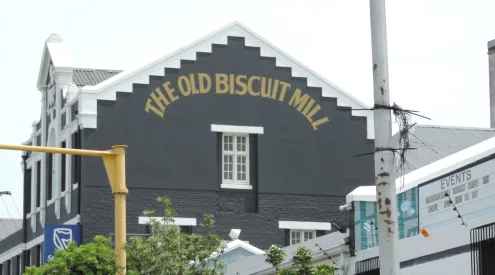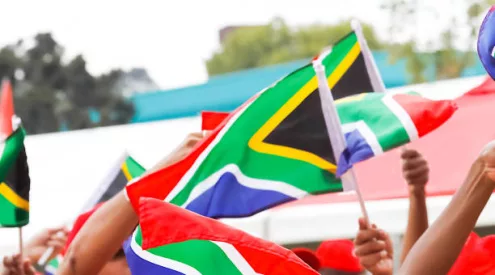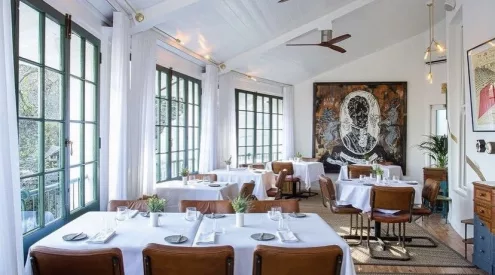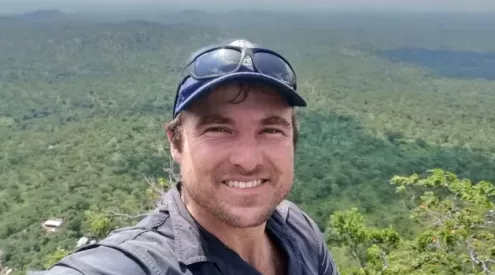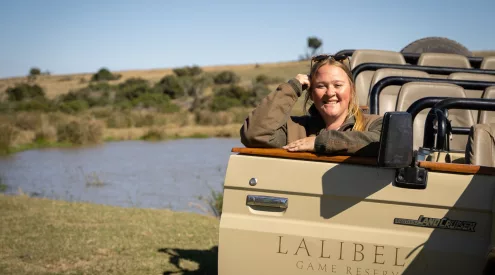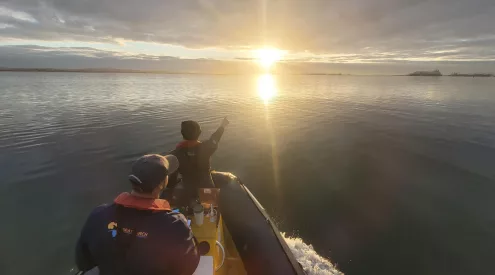The huge iSimangaliso Wetland Park in Kwazulu-Natal on the far northeast coast of South Africa is a truly impressive stretch of land, ocean and fresh water lakes and rivers.
At 332 000 hectares, it’s South Africa’s second largest protected natural area, after the Kruger National Park. (The Kgalagadi Transfrontier Park that straddles both Botswana and South Africa is bigger than Kruger, but the South African portion would be the third largest nature reserve, after Kruger and iSimangaliso).
Interestingly, it’s not a national park, but it is a World Heritage Site (great read: Africa’s 10 best World Heritage Sites), managed by the iSimangaliso Wetland Park authority and KZN Ezemvelo Wildlife. It probably should be a national park, because it deserves its place amongst the flagship protected areas on the continent.

A boardwalk out over Third Lake at Kosi Bay
The diversity of life at iSimangaliso is staggering,on a par with any of the large nature reserves in South Africa. There are 526 bird species (50% of the country’s, and 25% of Africa’s!), 36 snake species, 35 frog species (the most in the country), 5 species of turtle, 80 species of dragon fly, 110 species of butterflies, more than 2 000 species of flowering plants, more than 100 species of coral and hundreds of ocean and fresh water fish species, as well as a wide collection of African wildlife like elephant, hippo, buffalo, hyena and leopard (but no lion). It is one of two places in South Africa where it’s still possible to see a leopard walking on the beach (De Hoop Nature Reserve in the Western Cape is the other).
The reason for this astonishing collection of life? Isimangaliso, which appropriately means “miracle and wonder” in Zulu, contains some of the most diverse landscapes and ocean in Africa. There are more than 220 kilometres of ocean shoreline, eight interlocking ecosystems, including bushveld, grasslands, swamp forest, lakes and rivers, coastal dunes (some of the highest in the world), coral reefs and endless beaches.
The three major lake systems (Kosi Bay, Lake Sibaya and Lake St Lucia – all of which are some of the biggest fresh-water bodies in the country) drive the ecosystems, and all are separated from the ocean by a thin stretch of tall forested coastal dunes.
Kosi Bay (which isn’t really a bay) is a collection of four large lakes, each connected to each other via channels, and ultimately connected to the Indian Ocean near the border of Mozambique. The local Tongan people (who tend to see themselves as distinct from the Zulu), have used fish trips for hundreds of years at Kosi Bay, and the amount of fish moving up and down the lake system is impressive (although some species have been reduced over the years, as could be expected). Each lake’s salinity is different, depending on proximity to the sea.
Lake Sibaya is the largest body of fresh water in South Africa, but there is no river running into or out of it. It is simply groundwater that relies on rain to supplement the lake. Hippos and crocodiles are plentiful here – it’s the second-largest collection of these animals in KZN.
Lake St Lucia is the largest estuary in South Africa, 80kms long and 23kms wide. There are more than 1 000 hippos and crocodiles each in the estuary, as well as large flocks of pelicans, flamingos and a variety of fish species.

Hippos in the Kosi Lake system
A recent addition to iSimangaliso is uMkhuze Game Reserve, one of the most appealing wildlife reserves in the country. Close to 40 000 hectares in size, it has good numbers of wildlife, including elephant, rhino, hippo, crocodiles, leopard, hyenas and many different antelope and ungulate species.
Although iSimangaliso is South Africa’s first World Heritage Site (declared in 1999), this undoubted natural treasure almost fell prey to the curse of mining and unchecked development. In the late 1980s and early 1990s, a mining company (Richards Bay Minerals) wanted to mine the titanium in the dunes along this beautiful stretch of coastline. It’s quite a thought. Bulldozing and dredging the forests, the estuaries, the lakes, the rivers, the beaches, once you come here, you’ll be flabbergasted that someone could even consider it.
A coalition of organisations, backed by half a million ordinary citizens, as well as Nelson Mandela, petitioned the government to stop the mining license. The government fortunately had the foresight to ban mining, and to ensure that this area should be preserved for the future, and that ecotourism and sustainable utilization were the best forms of revenue generation. A similar battle -yet to be won by conservationists and communities – is currently being fought at the equally beautiful, but much smaller, Mkhambathi Nature Reserve on the Wild Coast. Read my blog about it here.
It was Nelson Mandela who said this about iSimangaliso: ‘It must be the only place on the globe where the oldest land mammal (the rhino) and the world’s biggest terrestrial animal (the elephant) share an ecosystem with the world’s oldest fish (the coelacanth) and the world’s biggest marine mammal (the blue whale).’
So with this in my mind, I started my journey in the far north at Kosi Bay. And what a place to begin my journey through iSimangaliso. While the rest of the country was in the grip of the first winter temperatures, I spent the weekend exploring the beaches, lakes and forests in my shorts and flip flops. The temperatures here hardly ever below 25 degrees, and during the day they can reach 35. The oceans and lakes are almost as warm!
The campsite at Kosi is spectacularly situated on Lake KuNhlange, the third and largest lake in the system, and there were few other visitors there. The water is warm as a bath, and although there are crocodiles and hippos, it’s safe to swim in the shallows during the day.
Fish eagles call regularly, and Kosi Bay also has one of the few palm-nut vulture colonies in the country. These beautiful, rare birds – which look more like eagles than vultures – fly over the campsite in the early morning and late afternoon to look for food in the raffia palm trees which are nearby (these are among the last-remaining raffia palms in the country).
Early one morning my friend Jenny and I hitched a ride with Steve de Lange on his boat trip around the lake system. It’s highly recommended. Steve will take you from third lake down to the first lake, and give you a great overview of the fish traps which the local Tongans have used for probably over 1 000 years. The first Portuguese explorers documented the traps about 700 years ago. Call Steve on 079-991-7714 to book a tour on his boat.
There’s also plenty of birdlife, hippos and a few crocs. If you are feeling brave, Steve recommends having a snorkel near the fish traps, to see how the young fish use the wooden structures as shelter from predatory fish. There are thousands of fish, and the water is crystal clear and warm, so it’s a great experience. But yes, there are crocs around, although Steve says they come out mainly at night.
That afternoon, we drove round to the estuary, where the lakes are connected to the ocean. The spring tide was coming in strongly, so we took our snorkels and masks and drifted with the incoming tide up the estuary, it’s like swimming in an aquarium. There were plenty of fish, of course, but also many eels and scorpionfish, so be careful about standing in the shallows, as you might get stung!
That evening we had a braai at our campsite, and a huge thunderstorm passed over us. It drenched everything, and lightning crashed about us, but we had our rooftop tent to stand under, and after half an hour, the storm passed, and the stars came out! I fell asleep to hippos grunting and rain drip-dropping off the false banana trees.
For more, go to www.yearinthewild.com and www.facebook.com/yearinthewild. Thanks again to my sponsors for making it all possible. CapeNature, South African National Parks, Ezemvelo KZN Wildlife, Eastern Cape Parks, iSimangaliso Wetland Park, Ford, Total, Evosat, Conqueror Trailers, Vodacom, Digicape, Lacie, Frontrunner, Safari Centre Cape Town, K-Way, EeziAwn, National Luna, Nokia , Garmin, Goodyear, Global Fleet Sales, Hetzner, Clearstream Consulting, Escape Gear and Trailcam Adventures.
Looking for accommodation near iSimangaliso? Look no further than Getaway Accommodation.


